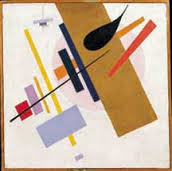In a not dissimilar way to Tate Modern’s Arshile Gorky retrospective in 2010, its current (till October 26th) – and, it seems to me, if you have any interest in 20th century art, unmissable – Malevich exhibition shows him moving through a range of early influences as he searches for a style of his own. So, as with Gorky, there are brushes with the Post-Impressionism of Cezanne and then the early Cubism of Picasso and Braque, as he moves towards a personal form of abstraction which takes him in a very different direction, leading to his famous, or infamous, Black Square, which seemed to block out/black out all that had gone before: an iconic full stop that would propel him towards the splendour of colour and form that he was to call Suprematism.
To stand in Room 7, at the pivotal centre of this exhibition, is to be surrounded by a glorious and controlled outpouring of image and ideas that was to dissolve only a few years later in the wake of Bolshevik Revolution of 1917.
Painting died, Malevich said, like the old regime, because it was an organic part of it.
He taught, and, when his work resumed it signalled a return, under the increasing strictures of Stalinism and Socialist Realism, to landscape, figuration and portraiture. With his death in 1935, his work all but disappeared from view, only re-emerging, in part, in the 1950s; it was not until the 1980s that his Black Square painting would be displayed again.



